
苏州大学医学部药学院 教 案 课程名称: Microbiology and Immunology 授课对象: 药学全英班 授课学时: 54 教材版本: Foundations in Microbiology 10th Edition
苏州大学医学部药学院 教 案 课程名称: Microbiology and Immunology 授课对象: 药学全英班 授课学时: 54 教材版本: Foundations in Microbiology 10th Edition
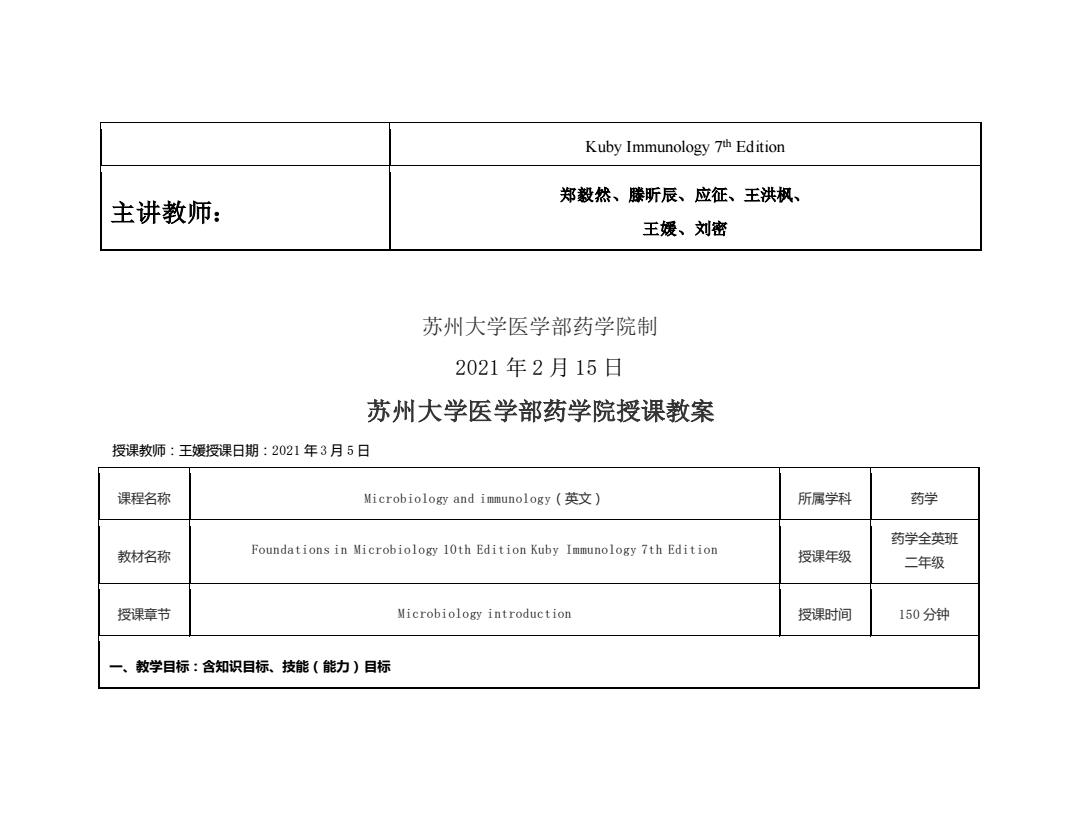
Kuby Immunology 7th Edition 郑毅然、滕昕辰、应征、王洪枫、 主讲教师: 王媛、刘密 苏州大学医学部药学院制 2021年2月15日 苏州大学医学部药学院授课教案 授课教师:王媛授课日期:2021年3月5日 课程名称 Microbiology and immunology(英文) 所属学科 药学 药学全英班 教材名称 Foundations in Microbiology 10th Edition Kuby Immunology 7th Edition 授课年级 二年级 授课章节 Microbiology introduction 授课时间 150分钟 一、教学目标:含知识目标、技能(能力)目标
Kuby Immunology 7th Edition 主讲教师: 郑毅然、滕昕辰、应征、王洪枫、 王媛、刘密 苏州大学医学部药学院制 2021 年 2 月 15 日 苏州大学医学部药学院授课教案 授课教师:王媛授课日期:2021 年 3 月 5 日 课程名称 Microbiology and immunology(英文) 所属学科 药学 教材名称 Foundations in Microbiology 10th Edition Kuby Immunology 7th Edition 授课年级 药学全英班 二年级 授课章节 Microbiology introduction 授课时间 150 分钟 一、教学目标:含知识目标、技能(能力)目标

1. 知识目标: (1)To understand the basic concepts of microbe and microbiology (2)To understand the methods,goals and advantages of microbiology studying (3)To understand the scope of microbes and general characteristics and cell structures of microorganisms (4)To know about the relationship between microbes and human 2.技能(能力)目标: (1)To know about the basic methods and procedures of microbiology study 二、授课内容(依据教学大纲)及时间分配 Lecture 1: (1)Definition of microbe and microbiology (2 min) (2)General Characteristics of Microorganisms and Their applications (5 min (3)The Cellular Organization of Microorganisms (10 min (4)Microbial Dimensions(4 min) (5)Human Use of Microorganisms (5 min) (6)General classification of Microorganisms (4 min) (7)Microbial Roles in Infectious Diseases (5 min)
1. 知识目标: (1) To understand the basic concepts of microbe and microbiology (2) To understand the methods, goals and advantages of microbiology studying (3) To understand the scope of microbes and general characteristics and cell structures of microorganisms (4) To know about the relationship between microbes and human 2. 技能(能力)目标: (1) To know about the basic methods and procedures of microbiology study 二、授课内容(依据教学大纲)及时间分配 Lecture 1: (1) Definition of microbe and microbiology (2 min) (2) General Characteristics of Microorganisms and Their applications (5 min) (3) The Cellular Organization of Microorganisms (10 min) (4) Microbial Dimensions(4 min) (5) Human Use of Microorganisms (5 min) (6) General classification of Microorganisms (4 min) (7) Microbial Roles in Infectious Diseases (5 min)

(8)Evolution of Microorganisms (5 min) (9)Methods of Microbial Investigation (10 min) Lecture 2: (10)Prokaryotic Profiles:The Bacteria and Archaea (4 min) (11)The Structure of a Generalized Bacterial Cell (5 min) (12)Cell Extensions and Surface Structures:Flagellum,Fimbriae and Pili,Bacterial Surface Coating,or Glycocalyx (5 min) (13)The Cell Envelope,Structure of Cell Walls,The Gram-Positive Cell Wall,Gram-negative Cell Wall (10 min) (14)Cell Membrane Structure (5 min) (15)Bacterial Internal Structure:Cell Cytoplasm(Chromosomes and Plasmids,Ribosomes,inclusions,Cytoskeleton,bacterial endospore (12 min) (16)Bacterial Shapes (4 min) (17)Other Prokaryotes (5 min) Lecture 3 (18)External Structures:Cilia and Flagella,The Glycocalyx,Cell Wall,Cytoplasmic Membrane (6 min) (19)Internal Structures:Nucleus (3 min)
(8) Evolution of Microorganisms (5 min) (9) Methods of Microbial Investigation (10 min) Lecture 2: (10) Prokaryotic Profiles: The Bacteria and Archaea (4 min) (11) The Structure of a Generalized Bacterial Cell (5 min) (12) Cell Extensions and Surface Structures: Flagellum, Fimbriae and Pili, Bacterial Surface Coating, or Glycocalyx (5 min) (13) The Cell Envelope, Structure of Cell Walls, The Gram -Positive Cell Wall, Gram-negative Cell Wall (10 min) (14) Cell Membrane Structure (5 min) (15) Bacterial Internal Structure: Cell Cytoplasm (Chromosomes and Plasmids, Ribosomes, inclusions, Cytoskeleton, bacterial endospore (12 min) (16) Bacterial Shapes (4 min) (17) Other Prokaryotes (5 min) Lecture 3 (18) External Structures: Cilia and Flagella, The Glycocalyx, Cell Wall, Cytoplasmic Membrane (6 min) (19) Internal Structures: Nucleus (3 min)
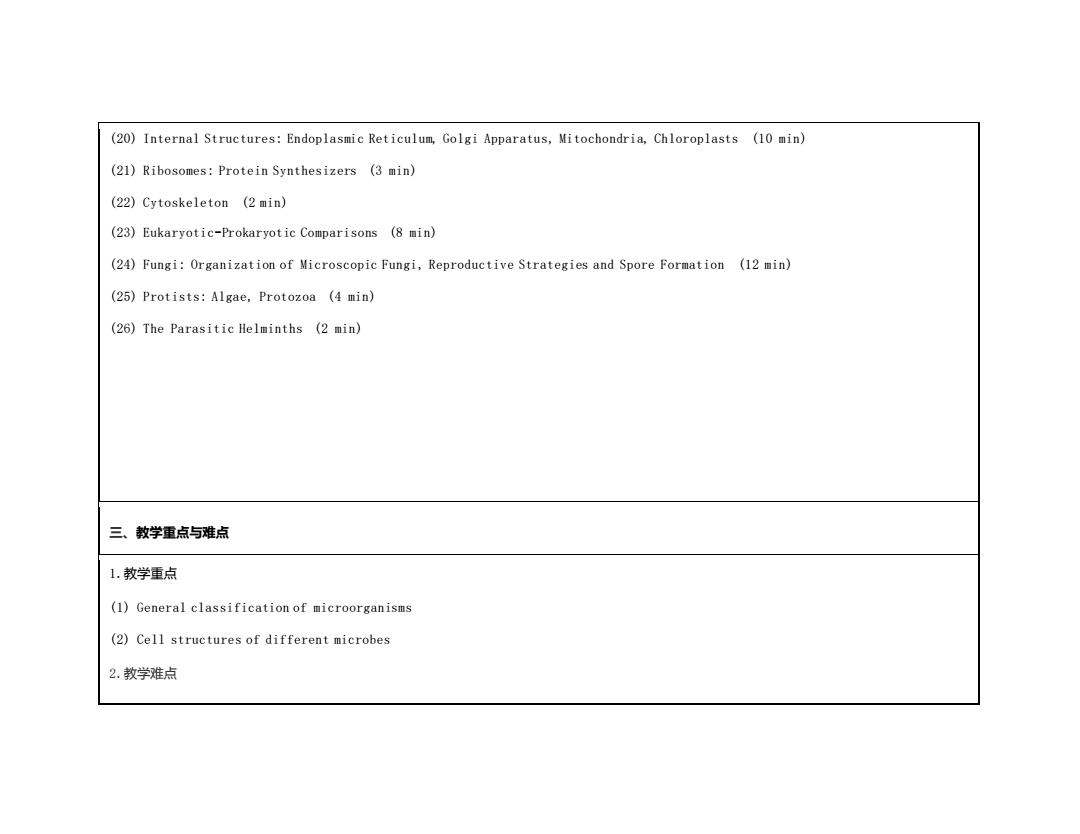
(20)Internal Structures:Endoplasmic Reticulum,Golgi Apparatus,Mitochondria,Chloroplasts (10 min) (21)Ribosomes:Protein Synthesizers (3 min) (22)Cytoskeleton (2 min) (23)Eukaryotic-Prokaryotic Comparisons (8 min) (24)Fungi:Organization of Microscopic Fungi,Reproductive Strategies and Spore Formation (12 min) (25)Protists:Algae,Protozoa (4 min) (26)The Parasitic Helminths (2 min) 三、教学重点与难点 1.教学重点 (1)General classification of microorganisms (2)Cell structures of different microbes 2.教学难点
(20) Internal Structures: Endoplasmic Reticulum, Golgi Apparatus, Mitochondria, Chloroplasts (10 min) (21) Ribosomes: Protein Synthesizers (3 min) (22) Cytoskeleton (2 min) (23) Eukaryotic-Prokaryotic Comparisons (8 min) (24) Fungi: Organization of Microscopic Fungi, Reproductive Strategies and Spore Formation (12 min) (25) Protists: Algae, Protozoa (4 min) (26) The Parasitic Helminths (2 min) 三、教学重点与难点 1.教学重点 (1) General classification of microorganisms (2) Cell structures of different microbes 2.教学难点
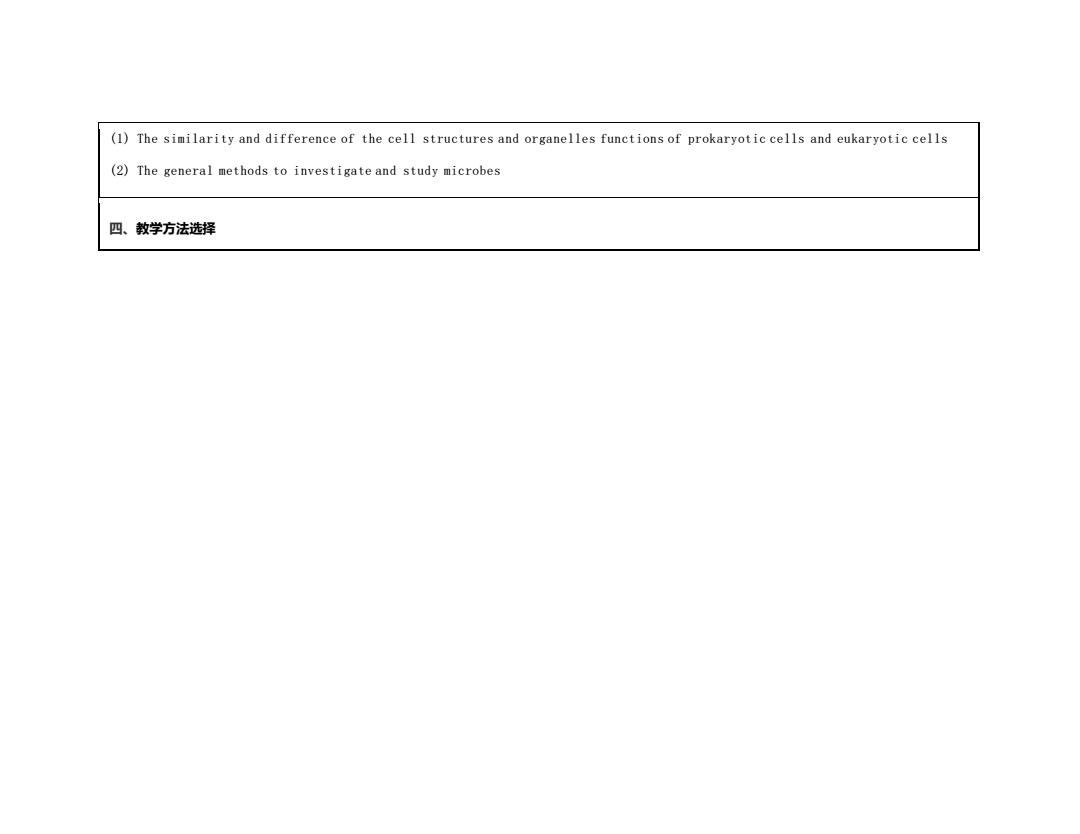
(1)The similarity and difference of the cell structures and organelles functions of prokaryotic cells and eukaryotic cells (2)The general methods to investigate and study microbes 四、教学方法选择
(1) The similarity and difference of the cell structures and organelles functions of prokaryotic cells and eukaryotic cells (2) The general methods to investigate and study microbes 四、教学方法选择
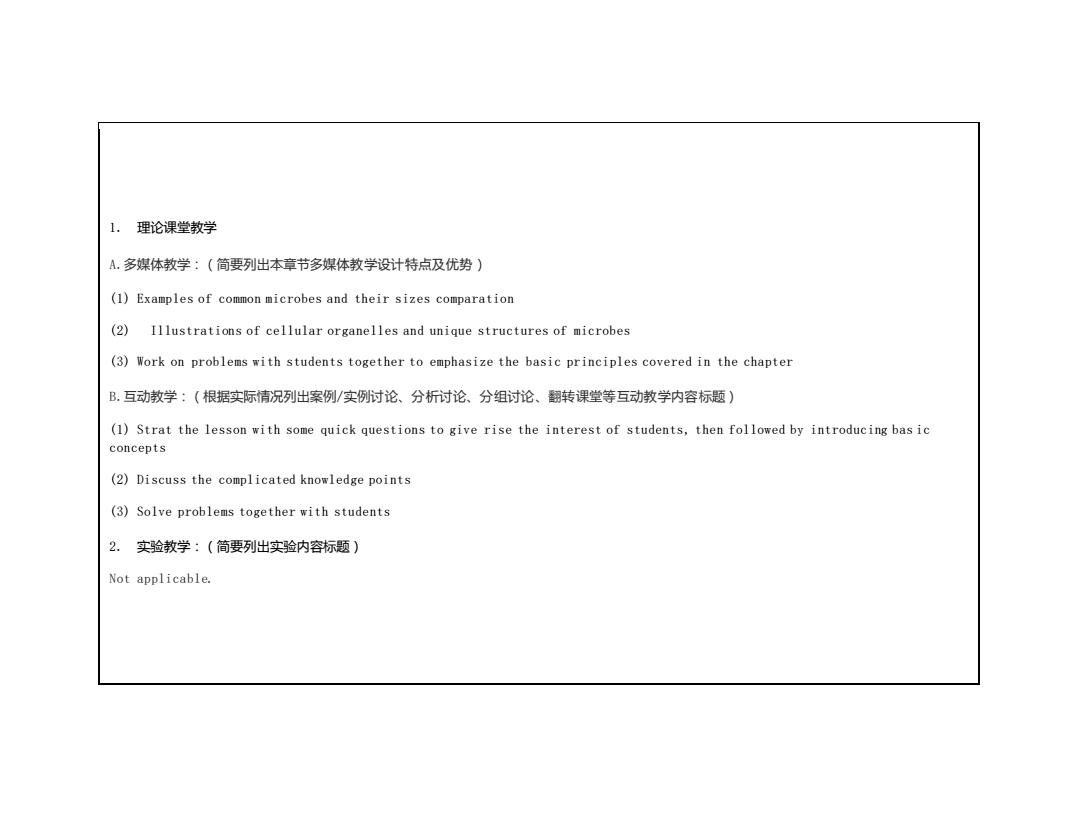
1.理论课堂教学 A.多媒体教学:(简要列出本章节多媒体教学设计特点及优势) (1)Examples of common microbes and their sizes comparation (2) Illustrations of cellular organelles and unique structures of microbes (3)Work on problems with students together to emphasize the basic principles covered in the chapter B.互动教学:(根据实际情况列出案例/实例讨论、分析讨论、分组讨论、翻转课堂等互动教学内容标题) (1)Strat the lesson with some quick questions to give rise the interest of students,then followed by introducing bas ic concepts (2)Discuss the complicated knowledge points (3)Solve problems together with students 2.实验教学:(简要列出实验内容标题) Not applicable
1. 理论课堂教学 A.多媒体教学:(简要列出本章节多媒体教学设计特点及优势) (1) Examples of common microbes and their sizes comparation (2) Illustrations of cellular organelles and unique structures of microbes (3) Work on problems with students together to emphasize the basic principles covered in the chapter B.互动教学:(根据实际情况列出案例/实例讨论、分析讨论、分组讨论、翻转课堂等互动教学内容标题) (1) Strat the lesson with some quick questions to give rise the interest of students, then followed by introducing bas ic concepts (2) Discuss the complicated knowledge points (3) Solve problems together with students 2. 实验教学:(简要列出实验内容标题) Not applicable

五、更新或补充内容提要 六、复习思考题 (1)What are the basic characteristics of prokaryotic cells and eukaryotic cells? (2)What the cellular makeup of microorganisms and their size range?and indicate how viruses differ from cellular microbes (3)What is the generalized anatomy of bacterial cells? (4)What is the structure and functions of cell walls?and what is the role of peptidoglycan? (5)Review the major differences and similarities between prokaryotic and eukaryotic cells 七、学习资源、课外自主学习参考
五、更新或补充内容提要 六、复习思考题 (1) What are the basic characteristics of prokaryotic cells and eukaryotic cells? (2) What the cellular makeup of microorganisms and their size range? and indicate how viruses differ from cellular microbes (3) What is the generalized anatomy of bacterial cells? (4) What is the structure and functions of cell walls? and what is the role of peptid oglycan? (5) Review the major differences and similarities between prokaryotic and eukaryotic cells 七、学习资源、课外自主学习参考
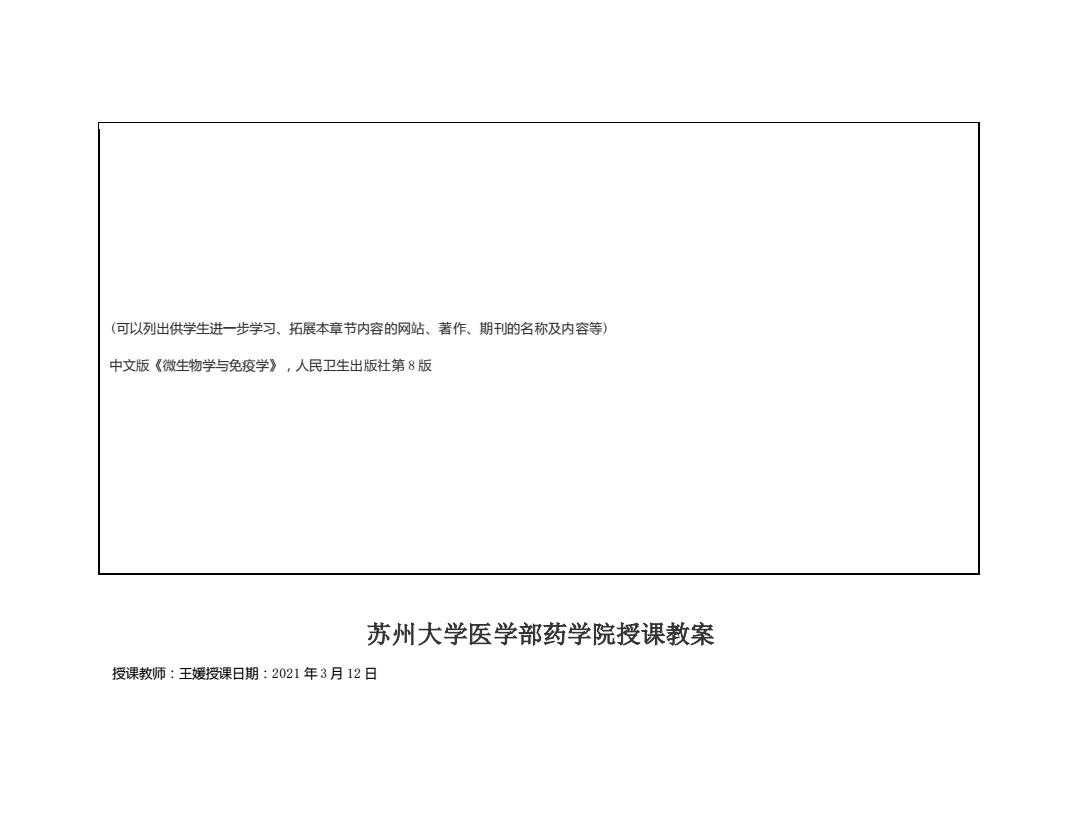
(可以列出供学生进一步学习、拓展本章节内容的网站、著作、期刊的名称及内容等) 中文版《微生物学与免疫学》,人民卫生出版社第8版 苏州大学医学部药学院授课教案 授课教师:王媛授课日期:2021年3月12日
(可以列出供学生进一步学习、拓展本章节内容的网站、著作、期刊的名称及内容等) 中文版《微生物学与免疫学》,人民卫生出版社第 8 版 苏州大学医学部药学院授课教案 授课教师:王媛授课日期:2021 年 3 月 12 日
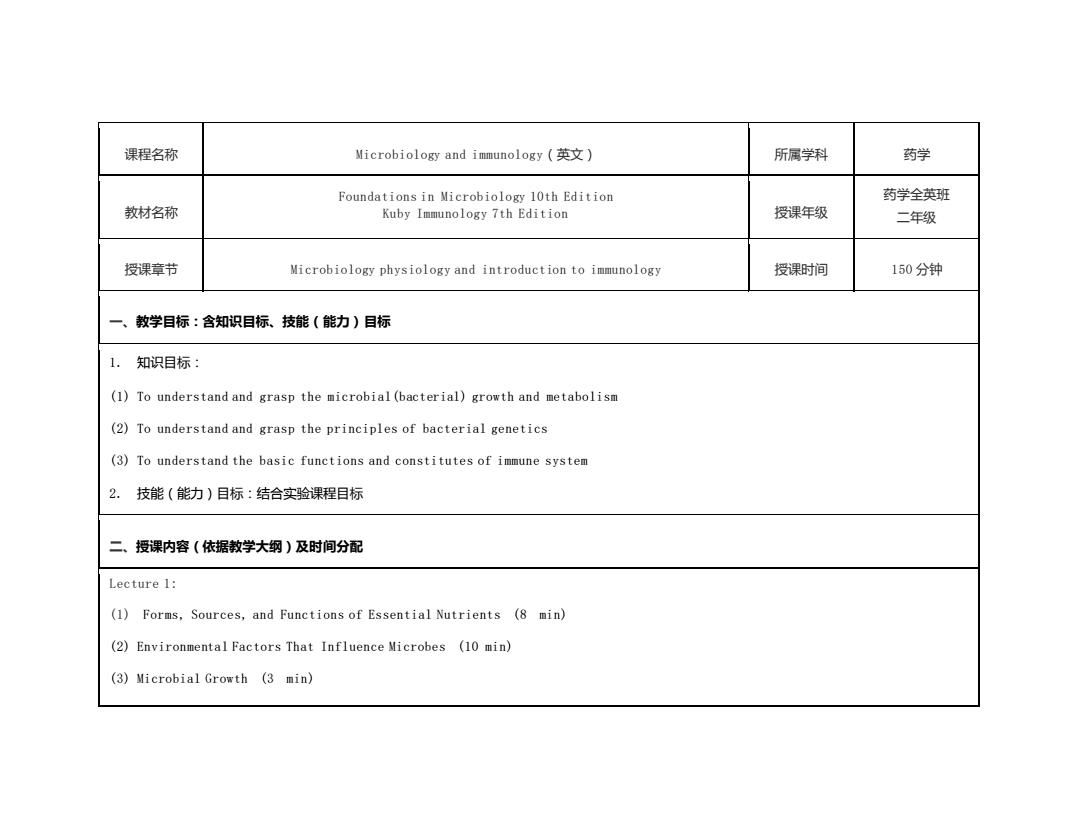
课程名称 Microbiology and immunology(英文) 所属学科 药学 Foundations in Microbiology 10th Edition 药学全英班 教材名称 Kuby Immunology 7th Edition 授课年级 二年级 授课章节 Microbiology physiology and introduction to immunology 授课时间 150分钟 一、教学目标:含知识目标、技能(能力)目标 1.知识目标: (1)To understand and grasp the microbial(bacterial)growth and metabolism (2)To understand and grasp the principles of bacterial genetics (3)To understand the basic functions and constitutes of immune system 2.技能(能力)目标:结合实验课程目标 二、授课内容(依据教学大纲)及时间分配 Lecture 1: (1)Forms,Sources,and Functions of Essential Nutrients (8 min) (2)Environmental Factors That Influence Microbes (10 min) (3)Microbial Growth (3 min)
课程名称 Microbiology and immunology(英文) 所属学科 药学 教材名称 Foundations in Microbiology 10th Edition Kuby Immunology 7th Edition 授课年级 药学全英班 二年级 授课章节 Microbiology physiology and introduction to immunology 授课时间 150 分钟 一、教学目标:含知识目标、技能(能力)目标 1. 知识目标: (1) To understand and grasp the microbial(bacterial) growth and metabolism (2) To understand and grasp the principles of bacterial genetics (3) To understand the basic functions and constitutes of immune system 2. 技能(能力)目标:结合实验课程目标 二、授课内容(依据教学大纲)及时间分配 Lecture 1: (1) Forms, Sources, and Functions of Essential Nutrients (8 min) (2) Environmental Factors That Influence Microbes (10 min) (3) Microbial Growth (3 min)